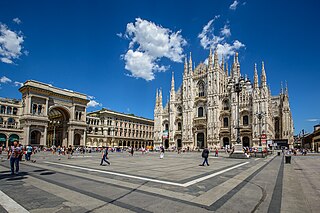
The Visconti of Milan are a noble Italian family. They rose to power in Milan during the Middle Ages where they ruled from 1277 to 1447, initially as Lords then as Dukes, and several collateral branches still exist. The effective founder of the Visconti Lordship of Milan was the Archbishop Ottone, who wrested control of the city from the rival Della Torre family in 1277.

Gotthard, also known as Gothard or Godehard the Bishop, was a German bishop venerated as a saint.

Ambrogio Bergognone was an Italian painter of the Renaissance period active in and near Milan.

Piazza del Duomo is the main piazza of Milan, Italy. It is named after, and dominated by, Milan Cathedral. The piazza marks the center of the city, both in a geographic sense and because of its importance from an artistic, cultural, and social point of view. Rectangular in shape, with an overall area of 17,000 m2, the piazza includes some of the most important buildings of Milan, as well some of the most prestigious commercial activities, and it is by far the foremost tourist attraction of the city.

Gian Maria Visconti was the second Visconti Duke of Milan, the son of Gian Galeazzo Visconti and Caterina Visconti. He was known to be cruel and was eventually assassinated. He had no children.

Castell'Arquato is an Italian town located on the first hills of Val D’Arda in the province of Piacenza, in Emilia-Romagna, approximately 30 kilometres (19 mi) from Piacenza and 35 kilometres (22 mi) from Parma. Places nearby include Bacedasco, Vigolo Marchese, Fiorenzuola d'Arda, Lugagnano Val d'Arda, and Vernasca. It is one of I Borghi più belli d'Italia.

Mastino II della Scala was lord of Verona. He was a member of the famous Scaliger family of Northern Italy.

The Battle of Parabiago was fought in February 1339 near Parabiago, in Lombardy, northern Italy, between the Milanese army and the St. George's Mercenaries of Lodrisio Visconti. A renowned condottiero, the latter was an exiled member of the Visconti family then in power in Milan with a kind of triumvirate formed by Azzone and his uncles, Luchino and Archbishop Giovanni Visconti. Aiming to return victoriously to his city, he hired some 2,500 knights, mainly from Germany, and 1,000 Swiss infantry which had fought in the unsuccessful war of Mastino II della Scala for the hegemony in northern Italy. These units were led by Werner von Urslingen and Konrad von Landau.
Lodrisio Visconti was an Italian condottiero.

Azzone Visconti was lord of Milan from 1329 until his death. After the death of his uncle, Marco Visconti, he was threatened with excommunication and had to submit to Pope John XXII. Azzone reconstituted his family's land holdings, taking numerous cities. He died in 1339.

Luchino Visconti (also spelled Lucchino, 1287 or 1292 – January 24, 1349) was lord of Milan from 1339 to 1349. He was also a condottiero, and lord of Pavia.

Galeazzo I Visconti was lord of Milan from 1322 to 1327. After being chosen Captain of Milan, he defeated two papal armies and was excommunicated by Pope John XXII. Temporarily imprisoned for murder, Galeazzo retired to Pescia and died in August 1328.

Isabella of France was a French princess and member of the House of Valois, as well as the wife of Gian Galeazzo Visconti, who after her death became Duke of Milan.

Elisabetta Visconti, also known as Elisabeth or Elizabeth, was a younger child of Bernabò Visconti and his wife, Beatrice Regina della Scala. Elisabetta was a member of the House of Visconti.

The Royal Palace of Milan was the seat of government in the Italian city of Milan for many centuries. Today, it serves as a cultural centre and it is home to international art exhibitions. It spans through an area of 7,000 square meters and it regularly hosts modern and contemporary art works and famous collections in cooperation with notable museums and cultural institutions from across the world. More than 1,500 masterpieces are on display annually.

Martino Aliprandi was an Italian lawyer and mayor of the 14th century.

The Visconti Castle of Binasco is a medieval castle in Binasco, Metropolitan City of Milan, Lombardy, Northern Italy. It is famous for having been the prison and execution place of Beatrice di Tenda, who was arrested and sentenced to death for adultery in 1418. Today, it is the seat of the Municipality of Binasco.

The Visconti Castle of Jerago is a castle of Middle Age origin located in Jerago, Lombardy, Northern Italy. Having been a property of members of the Visconti house between the 13th and 18th centuries, it retains still today their memory in its name.

Beatrice d’Este was an Italian noblewoman, now primarily known for Dante Alighieri's allusion to her in Purgatorio, the second canticle of the Divine Comedy. Through her first marriage to Nino Visconti, she was judge (giudichessa) of Gallura, and through her second marriage to Galeazzo I Visconti, following Nino’s death, lady of Milan.

Gothic art in Milan denotes the city's artistic period at the turn of the second half of the 13th century and the first half of the 15th century. The Gothic style, initially introduced into Milanese territory by Cistercian monks, was the main artistic style of the vast patronage and self-celebrating agenda of the Visconti family, lords of Milan, whose rule over the city is usually associated with the Milanese Gothic period.





















